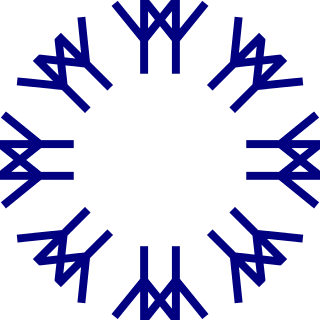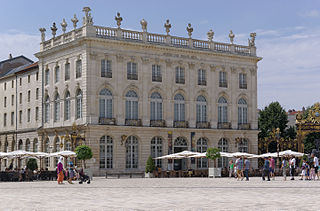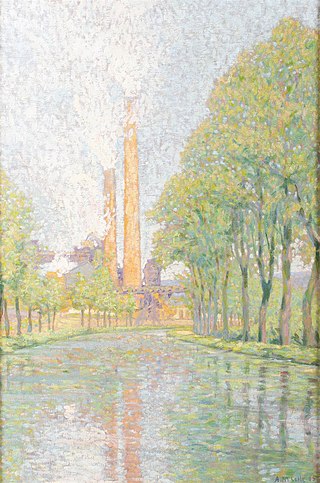
The 1967 International and Universal Exposition, commonly known as Expo 67, was a general exhibition from April 28 to October 27, 1967. It was a category one world's fair held in Montreal, Quebec, Canada. It is considered to be one of the most successful World's Fairs of the 20th century with the most attendees to that date and 62 nations participating. It also set the single-day attendance record for a world's fair, with 569,500 visitors on its third day.

Nancy is the prefecture of the northeastern French department of Meurthe-et-Moselle. It was the capital of the Duchy of Lorraine, which was annexed by France under King Louis XV in 1766 and replaced by a province, with Nancy maintained as capital. Following its rise to prominence in the Age of Enlightenment, it was nicknamed the "capital of Eastern France" in the late 19th century. The metropolitan area of Nancy had a population of 511,257 inhabitants at the 2018 census, making it the 16th-largest functional urban area in France and Lorraine's largest. The population of the city of Nancy proper is 104,885.

The Exposition Universelle of 1900, better known in English as the 1900 Paris Exposition, was a world's fair held in Paris, France, from 14 April to 12 November 1900, to celebrate the achievements of the past century and to accelerate development into the next. It was the sixth of ten major expositions held in the city between 1855 and 1937. It was held at the esplanade of Les Invalides, the Champ de Mars, the Trocadéro and at the banks of the Seine between them, with an additional section in the Bois de Vincennes, and it was visited by more than fifty million people. Many international congresses and other events were held within the framework of the exposition, including the 1900 Summer Olympics.
The year 1909 in architecture involved some significant events.

The Exposition Universelle of 1889, better known in English as the 1889 Paris Exposition, was a world's fair held in Paris, France, from 5 May to 31 October 1889. It was the fifth of ten major expositions held in the city between 1855 and 1937. It attracted more than thirty-two million visitors. The most famous structure created for the exposition, and still remaining, is the Eiffel Tower.

Expo 58, also known as the 1958 Brussels World's Fair, was a world's fair held on the Heysel/Heizel Plateau in Brussels, Belgium, from 17 April to 19 October 1958. It was the first major world's fair registered under the Bureau International des Expositions (BIE) after World War II.

The International Exhibition of Modern Decorative and Industrial Arts was a specialized exhibition held in Paris, France, from April to October 1925. It was designed by the French government to highlight the new modern style of architecture, interior decoration, furniture, glass, jewelry and other decorative arts in Europe and throughout the world. Many ideas of the international avant-garde in the fields of architecture and applied arts were presented for the first time at the exposition. The event took place between the esplanade of Les Invalides and the entrances of the Grand Palais and Petit Palais, and on both banks of the Seine. There were 15,000 exhibitors from twenty different countries, and it was visited by sixteen million people during its seven-month run. The modern style presented at the exposition later became known as "Art Deco", after the exposition's name.
Daum is a crystal studio based in Nancy, France, founded in 1878 by Jean Daum (1825–1885). His sons, Auguste Daum (1853–1909) and Antonin Daum (1864–1931), oversaw its growth during the burgeoning Art Nouveau period. Daum is one of the only crystal manufacturers toe employ the pâte de verre process for art glass and crystal sculptures, a technique in which crushed glass is packed into a refractory mould and then fused in a kiln.

Pont-Aven School encompasses works of art influenced by the Breton town of Pont-Aven and its surroundings. Originally the term applied to works created in the artists' colony at Pont-Aven, which started to emerge in the 1850s and lasted until the beginning of the 20th century. Many of the artists were inspired by the works of Paul Gauguin, who spent extended periods in the area in the late 1880s and early 1890s. Their work is frequently characterised by the bold use of pure colour and their Symbolist choice of subject matter.

Eugène Vallin was a French furniture designer and manufacturer, as well as an architect.

The Musée de l'École de Nancy is a museum devoted to the École de Nancy, an Art Nouveau movement founded in 1901 by Émile Gallé, Victor Prouvé, Louis Majorelle, Antonin Daum and Eugène Vallin in the city of Nancy in Lorraine, north-eastern France. They were joined by other artists, notably Jacques Grüber.

The Museum of Fine Arts of Nancy, one of the oldest museums in France, is housed in one of the pavilions on the Place Stanislas, in the heart of the 18th-century urban ensemble, a World Heritage Site by UNESCO. The museum displays an important collection of European paintings and is largely open to design, including a gallery dedicated to Jean Prouvé or the Daum factory.

The Ghent International Exposition of 1913 was a world's fair held in Ghent, Belgium, from 26 April to 3 November 1913.

Henri Paul Royer was a French painter, remembered especially for his genre works from Brittany. A painter of genre, portraitist and landscape artist, he travelled both in America and Europe during his life.

The Galerie des machines was a pavilion built for the 1889 Exposition Universelle in Paris. Located in the Grenelle district, the huge pavilion was made of iron, steel and glass.

Victor Prouvé was a French painter, sculptor and engraver of the Art Nouveau École de Nancy.

The Danish National Exhibition of 1909 or The National Exhibition in Aarhus 1909 was an industry, crafts and culture exhibition held in Aarhus, Denmark in 1909 from 18 May to 3 October. The exhibition displayed some 1850 individual works by architects, artists, craftsmen and businesses and attracted 650.000 visitors. The project was a large undertaking for the city with long-lasting effects on cultural institutions and short-term economic problems. The exhibition fairgrounds was named The white City based on the architectural expression chosen by the leading architect Anton Rosen.

The National Ecuadorian Exposition was a world's fair held in Quito in 1909 to mark 100 years since the start of the campaign for Ecuadorian independence from Spain.

Virginie Mauvais, French teacher and benefactor, was born and died in Nancy, France. She worked as a teacher and then an inspector of the Nancy municipal schools, and was a generous donor to the local hospital and other charities there.

Auguste-Michel Colle, sometimes known as Michel-Auguste Colle, a French painter of the Nancy school, active from c. 1900 to c. 1940. His pictures are in a number of private and public collections in France and elsewhere, including the Musée d'Arts de Nantes, the Musée des Beaux-Arts de Nancy, the Musée de l'École de Nancy; the Musée de l'Histoire du Fer, also in Nancy; the Pierre Noël Museum in Saint Dié: and the Musée des Marais Salants, in Batz-Sur-Mer.


















